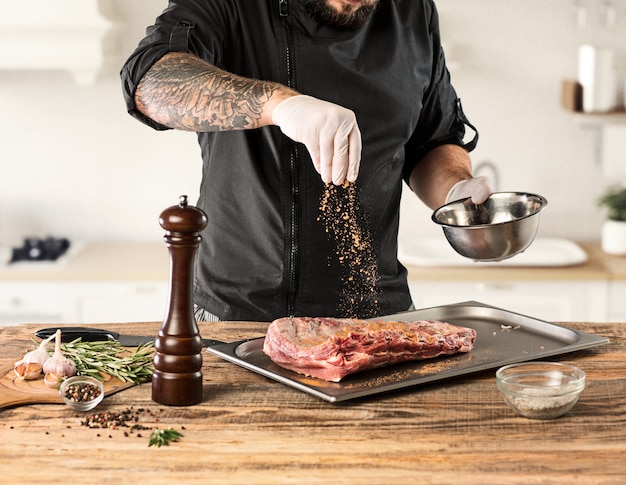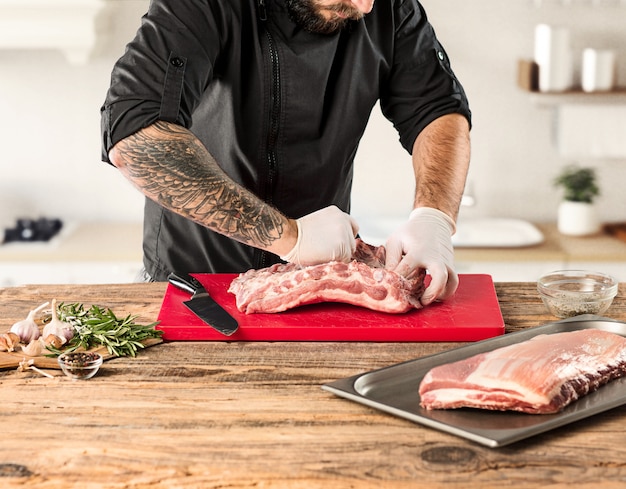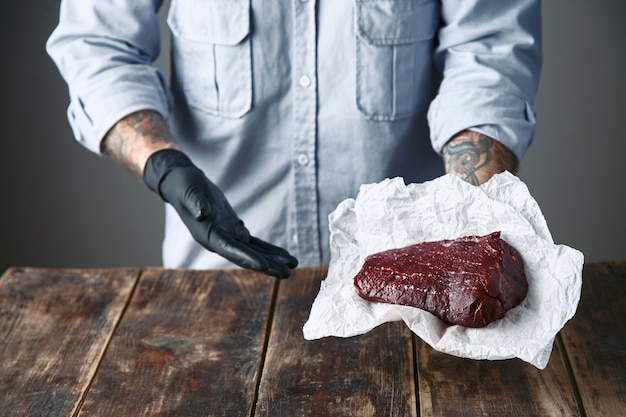(Part 1) The Lowdown on Gator Meat

The Alligator: A Culinary Curiosity
Let's get the basics out of the way. Alligator meat isn't just some strange novelty. It's actually quite lean and packed with protein. It's also low in fat and cholesterol, making it a healthier alternative to some other red meats. The texture is a bit like chicken or pork, but with a slightly firmer bite. The flavour is delicate and can be adapted to various cooking methods.
I remember the first time I tried it. I was at a Southern restaurant, and the menu featured a "Gator Sausage Po' Boy". I was hesitant, but my adventurous spirit won out. It was surprisingly tasty! The sausage was spicy and flavorful, and the bread was soft and pillowy. I was hooked.
Where to Find Alligator Meat: Beyond the Swamp
Now, you're not going to find alligator at your local supermarket just yet, but it's becoming more readily available. You can find it at some specialty butcher shops or online retailers. If you're in the Southern US, you might even find it at farmers' markets. When you're buying gator, be sure to check for quality, just like you would with any other meat. Look for fresh cuts with a nice firm texture, and avoid any that have a strong or unpleasant odour.
The Different Cuts of Alligator: Choosing Your Adventure
Just like beef, alligator meat comes in different cuts, each with its own unique characteristics. Here's a breakdown of some of the most common:
- Tail: This is the most popular cut and is often compared to chicken drumsticks. The meat is tender and juicy, perfect for grilling or frying. Think of it as the "crowd-pleasing" cut.
- Back Straps: This is a leaner cut from the alligator's back, making it ideal for roasting or grilling. It has a more pronounced grain than the tail, giving it a slightly more textured bite.
- Legs: These are tougher cuts, but they can be cooked for a long time to break down the connective tissue and become tender. Great for stews or soups, perfect for a slow-cooked meal.
- Tenderloin: The most tender and delicate cut, it's often grilled or pan-seared. Quite a treat, but it can be pricey. This is for the true gator connoisseurs.
(Part 2) Preparing Alligator Meat: A Step-by-Step Guide

Getting the Gator Ready for Cooking: Prepping Your Catch
Once you've got your alligator meat, it's time to prep it. First things first, give it a good rinse under cold water. You can then trim away any excess fat or gristle, and if you're using a tail, you might want to remove the skin. The skin can be tough, but some people enjoy the flavour, so it's up to you.
The Art of Skinning: A Skill Worth Mastering
Skinning an alligator tail might seem daunting, but it's actually pretty simple. You can find plenty of tutorials online, or ask your butcher to skin it for you. The key is to make a cut down the belly of the tail, then carefully peel back the skin. It's a bit like peeling a banana, really. Once you've got the skin off, you can cut the tail into the size of pieces you want.
I remember the first time I attempted to skin a gator tail. I was with my uncle, a seasoned gator hunter. He showed me the ropes, and it wasn't as scary as I imagined. He even told me a funny story about the time he got a little too close to a gator's tail while trying to skin it!
Marination Magic: Elevating the Flavor
Marination is key to enhancing the flavour of your alligator meat. You can use any marinade you like, but I'd recommend something that's bold and flavorful to cut through the slightly gamy taste. I find that marinades with citrus juices, garlic, herbs, and spices work really well.
The Marinating Process: A Time for Flavor Transformation
The marinating time will depend on the recipe and your personal preference. Anything from 30 minutes to overnight is fine. I usually marinate for a couple of hours, just enough to let the flavours sink in. Don't forget to cover the meat and refrigerate it while it's marinating.
(Part 3) Cooking Alligator: A culinary adventure

The Ultimate Guide to Cooking Alligator: Mastering the Art
You've got your prepped gator meat, ready to go. Now, let's get cooking! Alligator meat is very versatile, and can be cooked in a variety of ways. Here are some of my favourite methods:
Grilling: The Classic Approach
Grilling is a classic way to cook alligator meat, and it allows the natural flavor to shine through. I love grilling alligator steaks with a simple seasoning of salt, pepper, and garlic powder. Don't overcook it though, you want to keep it juicy.
I remember one summer barbecue where I grilled some gator steaks for my friends. They were skeptical at first, but then they took a bite and were blown away! The meat was tender and flavorful, and the smoky char from the grill added another layer of depth.
Pan-Frying: A Quick and Easy Option
Pan-frying is a great option if you're short on time. Simply heat some oil in a pan, and cook the alligator meat over medium-high heat until it's cooked through. You can add some butter and herbs towards the end to enhance the flavour.
Roasting: For a Hearty Meal
Roasting alligator meat is a great way to cook it for a larger gathering. Simply rub the meat with a spice rub, then roast it in the oven until it's tender and cooked through. You can also add some vegetables to the roasting pan for a complete meal.
Sous Vide: A Modern Twist
If you're feeling adventurous, you can try cooking alligator meat sous vide. This method ensures that the meat is cooked perfectly evenly, and it also helps to keep it juicy and tender. Just seal the meat in a vacuum bag, then cook it in a water bath at a low temperature for a long period of time.
Deep-Frying: For a Crispy Treat
Deep-frying is a popular way to cook alligator meat, and it results in a crispy and flavorful dish. Just dip the meat in batter or bread crumbs, then fry it until it's golden brown. Serve it with dipping sauce, and enjoy!
Stewing and Braising: Tenderizing Tough Cuts
As I mentioned before, the tougher cuts of alligator can be used for stews and braises. slow cooking helps to break down the connective tissue and make the meat tender and flavorful. You can use a slow cooker or a dutch oven, and add any flavour combinations you like.
(Part 4) Alligator Recipes: A Taste of the South
From Simple to Spectacular: The Best Alligator Recipes
I've shared some general cooking tips, but now it's time for some concrete recipes. Here are some of my favorites, ranging from simple to more adventurous.
1. Grilled Alligator with Lemon Herb Butter: A Classic with a Twist
This recipe is a classic for a reason: it's simple, flavorful, and easy to make. You'll need:
- Alligator steaks
- Olive oil
- Salt and pepper
- Garlic powder
- Lemon juice
- Chopped fresh herbs (parsley, thyme, basil)
- Butter
First, marinate the alligator steaks in a mixture of olive oil, salt, pepper, garlic powder, lemon juice, and fresh herbs. Then, grill them over medium heat for about 5-7 minutes per side, until cooked through. Finally, melt some butter and stir in some fresh herbs. Drizzle this herb butter over the grilled alligator, and serve.
For an extra touch, I sometimes add a squeeze of fresh lime juice over the steaks before serving. The citrus acidity cuts through the richness of the butter, creating a beautiful balance of flavors.
2. Pan-Seared Alligator with Mango Salsa: A Fusion of Flavors
This recipe is a fusion of flavors, with the sweet and tangy mango salsa complementing the savory alligator. You'll need:
- Alligator steaks
- Olive oil
- Salt and pepper
- Garlic powder
- Mango, diced
- Red onion, diced
- Jalapeno pepper, finely chopped (optional)
- Cilantro, chopped
- Lime juice
Season the alligator steaks with salt, pepper, and garlic powder. Heat some olive oil in a pan and sear the steaks for 3-4 minutes per side, until cooked through. Meanwhile, mix together the diced mango, red onion, jalapeno, cilantro, and lime juice. Serve the seared alligator with a generous dollop of mango salsa.
If you're looking for a spicier kick, you can add a pinch of cayenne pepper to the mango salsa. The heat will complement the sweetness of the mango and the savory flavor of the alligator.
3. Alligator Jambalaya: A Hearty Southern Classic
This recipe is a Southern classic, and it's a great way to use alligator meat in a hearty and flavorful dish. You'll need:
- Alligator meat, diced
- Olive oil
- Onion, chopped
- Green bell pepper, chopped
- Celery, chopped
- Garlic, minced
- Cajun seasoning
- chicken broth
- long-grain rice
- Tomatoes, diced
- Shrimp (optional)
Heat some olive oil in a large pot, and sauté the onion, green pepper, celery, and garlic until softened. Add the diced alligator meat and Cajun seasoning, and cook until browned. Pour in the chicken broth and bring to a boil. Stir in the rice and diced tomatoes. Reduce heat, cover, and simmer for about 20 minutes, or until the rice is cooked through. Add shrimp in the last few minutes, if desired.
Jambalaya is a dish that's all about sharing. It's perfect for a family gathering or a potluck. The flavors blend beautifully, creating a symphony of spices and textures.
4. Deep-Fried Alligator Nuggets: A Casual Snack with a Bite
This recipe is perfect for a casual gathering or game-day snack. You'll need:
- Alligator meat, diced
- All-purpose flour
- Salt and pepper
- Cajun seasoning
- Eggs, beaten
- Breadcrumbs
- vegetable oil
In a bowl, mix together the flour, salt, pepper, and Cajun seasoning. In another bowl, whisk together the eggs. In a third bowl, place the breadcrumbs. Dip the diced alligator meat in the flour mixture, then the egg mixture, and finally the breadcrumbs. Heat the vegetable oil in a deep fryer or large pot, and fry the alligator nuggets until golden brown and cooked through. Serve with your favorite dipping sauce.
Alligator nuggets are a fun and unexpected twist on a classic snack. They're perfect for parties, tailgates, or just a quick and easy meal. Just be sure to serve them with plenty of napkins, because they can be a bit messy!
5. Alligator Chili: A Hearty and Satisfying Meal
This recipe is a hearty and satisfying meal, and it's perfect for a cold winter day. You'll need:
- Alligator meat, diced
- Olive oil
- Onion, chopped
- Garlic, minced
- Green bell pepper, chopped
- Chili powder
- Cumin
- Cayenne pepper
- Tomato sauce
- Chicken broth
- kidney beans, drained
- pinto beans, drained
Heat some olive oil in a large pot, and sauté the onion, garlic, and green pepper until softened. Add the diced alligator meat, chili powder, cumin, cayenne pepper, and cook until browned. Pour in the tomato sauce and chicken broth. Add the kidney beans and pinto beans, and bring to a boil. Reduce heat, cover, and simmer for about 30 minutes, or until the chili has thickened. Serve with your favorite toppings, such as cheese, sour cream, or avocado.
Alligator chili is a delicious way to warm up on a cold day. The chili is full of flavor, and the alligator meat adds a unique twist. Serve it with a side of cornbread for a truly Southern meal.
(Part 5) Alligator Beyond the Kitchen: A Cultural Dive
Gator's Place in Southern Culture: A Culinary Tradition
Alligator isn't just a meal, it's woven into the fabric of Southern culture. In the US South, especially Louisiana and Florida, gator has a long history as a food source. It's often seen as a symbol of the region's resilience and connection to the natural world.
The Gator's Role in the Ecosystem: A Balancing Act
Now, before you get carried away with gator-themed dinners, let's talk about the ecological side. Alligators play an important role in maintaining the health of their swampy habitats. They're top predators, keeping other populations in check. Responsible hunting practices help ensure gator populations stay healthy, so we can enjoy this unique ingredient.
The Alligator's Image: Fear vs. Fascination
For some, the thought of eating alligator conjures up images of scaly monsters. But, believe me, the meat itself is pretty tame! It's a testament to how we can learn to appreciate creatures we initially fear. The more we understand the creatures we share the planet with, the more respectful our relationship with them becomes.
(Part 6) Alligator Eating Etiquette: A Guide to Savvy Consumption
From Farm to Plate: A Responsible Approach
Here's a key point: choosing ethically sourced alligator is crucial. Look for farms and hunters who follow sustainable practices.
I've been fortunate to visit some alligator farms in the South. I was impressed by the commitment to responsible practices, from habitat management to humane harvesting methods. It's a testament to the growing awareness of the importance of sustainable agriculture.
The Alligator's Environmental Impact: Making Informed Choices
Let's be clear: alligator farming can have its own environmental impact. But, compared to the meat industry's impact on land use and greenhouse gasses, alligator meat can be a relatively low-impact choice. It's all about making informed choices and supporting responsible practices.
Making the Most of Every Part: Minimizing Waste, Maximizing Value
There's a growing movement to utilize every part of the animal, reducing waste and maximizing value. Gator skin is used for leather goods, and even the bones can be used for broth and stock. It's all part of building a more sustainable approach to food.
(Part 7) Alligator in the World: From Louisiana to Beyond
Gator's Global Appeal: A culinary journey
While alligator is a Southern staple, its appeal is spreading beyond the US. You'll find it on menus in places like Europe and Asia. This global interest is a sign of our growing appreciation for diverse culinary experiences and sustainable ingredients.
Alligator's Cultural Significance: More Than Just a Meal
Alligator is a cultural icon, inspiring art, music, and literature. It's a reminder that food connects us to history, geography, and cultural identity.
A Culinary Adventure Awaits: Embrace the Unusual
So, if you're looking for something unique and adventurous, why not give alligator a try? You might be surprised at how delicious it is, and how it opens up a whole new world of culinary possibilities.
(Part 8) FAQs: Your Alligator Questions Answered
1. Is alligator meat safe to eat?
Yes, alligator meat is perfectly safe to eat, as long as it's properly handled and cooked. Just like any other meat, it's important to cook it to the correct internal temperature to kill any bacteria.
The USDA recommends cooking alligator meat to an internal temperature of 145°F (63°C). You can use a meat thermometer to check the temperature.
2. What does alligator meat taste like?
Alligator meat has a delicate flavor that's often described as being similar to chicken or pork. It has a slightly gamey taste, but it's not as strong as some other wild game meats.
The taste of alligator can vary depending on how it's prepared. It can be mild and delicate, or it can have a more pronounced flavor, depending on the cooking method and the seasonings used.
3. How do I know if alligator meat is fresh?
Fresh alligator meat should have a firm texture and a slightly sweet smell. Avoid any meat that has a strong or unpleasant odor, or that feels slimy or sticky.
If you're buying alligator meat from a butcher or a farmer's market, ask them about the source of the meat and how it was harvested. Look for meat that's been properly refrigerated and handled.
4. What are some good side dishes for alligator?
Alligator goes well with a variety of side dishes. Some popular choices include rice, potatoes, vegetables, and salads. You can also serve it with dipping sauces, such as mango salsa, remoulade, or barbecue sauce.
I often like to pair alligator with dishes that have a bit of a Southern flair. For example, I love serving it with collard greens, black-eyed peas, or cornbread.
5. Can I find alligator meat at my local grocery store?
Alligator meat is not typically found at most grocery stores. However, it's becoming more readily available at specialty butcher shops, online retailers, and farmers' markets in some areas.
If you're not sure where to find alligator meat in your area, you can try searching online or calling local butcher shops. You can also check with farmers' markets in your region.
Everyone is watching

How to Cook Frozen Lobster Tails Perfectly: A Step-by-Step Guide
RecipesLobster. Just the word conjures up images of lavish meals, special occasions, and a taste of luxury. But let's...

Pigs in a Blanket Cooking Time: How Long to Bake for Perfect Results
RecipesAh, pigs in a blanket. Just the name conjures up images of those delightful little parcels of crispy pastry en...

Pork Fillet Cooking Time: How Long to Cook It Perfectly
RecipesPork fillet, or tenderloin as it's sometimes called, is a real favourite in our house. It's so versatile, and...

The Ultimate Guide to Cooking Delicious Frankfurters
RecipesLet's face it, we all love a good frankfurter. It's a classic, simple, and always satisfying. But let's be rea...

Wolf Meat Recipes: A Guide to Cooking Wild Game
RecipesLet's be honest, you don't see wolf meat at your local butcher shop every day. It's a bit of a wild card, but ...
